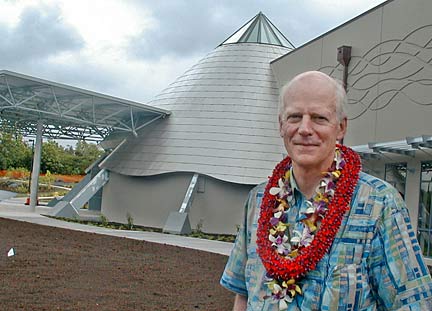
|
Astronomy museum
melds past, present
HILO » The Mauna Kea Astronomy Education Center will bridge "the voyages of ancient and modern Hawaiians with those of astronomers," a center brochure says.
"If we achieve this, we will have something to teach the world about how to take the best of modern science and indigenous culture," said Peter Giles, introduced by the University of Hawaii at Hilo this week as the center's new director.
Giles takes over Sept. 1 with the goal of supplying the Hilo museum with exhibits and opening it to the public by the end of the year.
He replaces director Marlene Hapai, a university biology professor who gave birth to a concept in 1993 that led to the 40,000-square-foot museum and who has been in charge of its construction since January 2004.
U.S. Sen. Daniel Inouye has been a major force behind the center, channeling $28 million to it through NASA. As early as 1995, Inouye linked Hapai's science idea to displays of Hawaiian concepts of the universe.
There have been some differences, such as the criticism by some Hawaiians of observatories on Mauna Kea.
Giles said the museum will show "science can be pursued without losing the powerful qualities of being Hawaiian."
Every exhibit in the museum will be described in Hawaiian as well as English. In the Kumulipo exhibit, showing the Hawaiian view of the creation of the world, the audio narration will be in Hawaiian with English in subtitles only, Hapai said while giving a tour of the building.
Even the landscaping of the museum's nine acres on the UH-Hilo campus is done in Hawaiian cultural zones, such as the lowland "realm of people" and the upland "realm of the spirit."
Coming from California's Silicon Valley, Giles has bridged cultures before. He recalled the challenge he faced as president of the Tech Museum of Innovation in San Jose, Calif., from 1987 to 2005.
"People were living within a stone's throw of the most advanced technology in the world and having not a clue about what was going on inside," he said.
The goal now will be to make the Mauna Kea museum an economic success, finding $3 million a year in operating money, he said.
A goal of 250,000 visitors per year will be sought, with a third, at most, coming from the Big Island. Cruise ship visitors are expected to be a large component.
Museums like this normally get only half their income from attendance fees, with the rest coming from government grants and private donations, Giles said.
maunakea.hawaii.edu/
E-mail to City Desk
[News] [Business] [Features] [Sports] [Editorial] [Do It Electric!]
[Classified Ads] [Search] [Subscribe] [Info] [Letter to Editor]
[Feedback]
